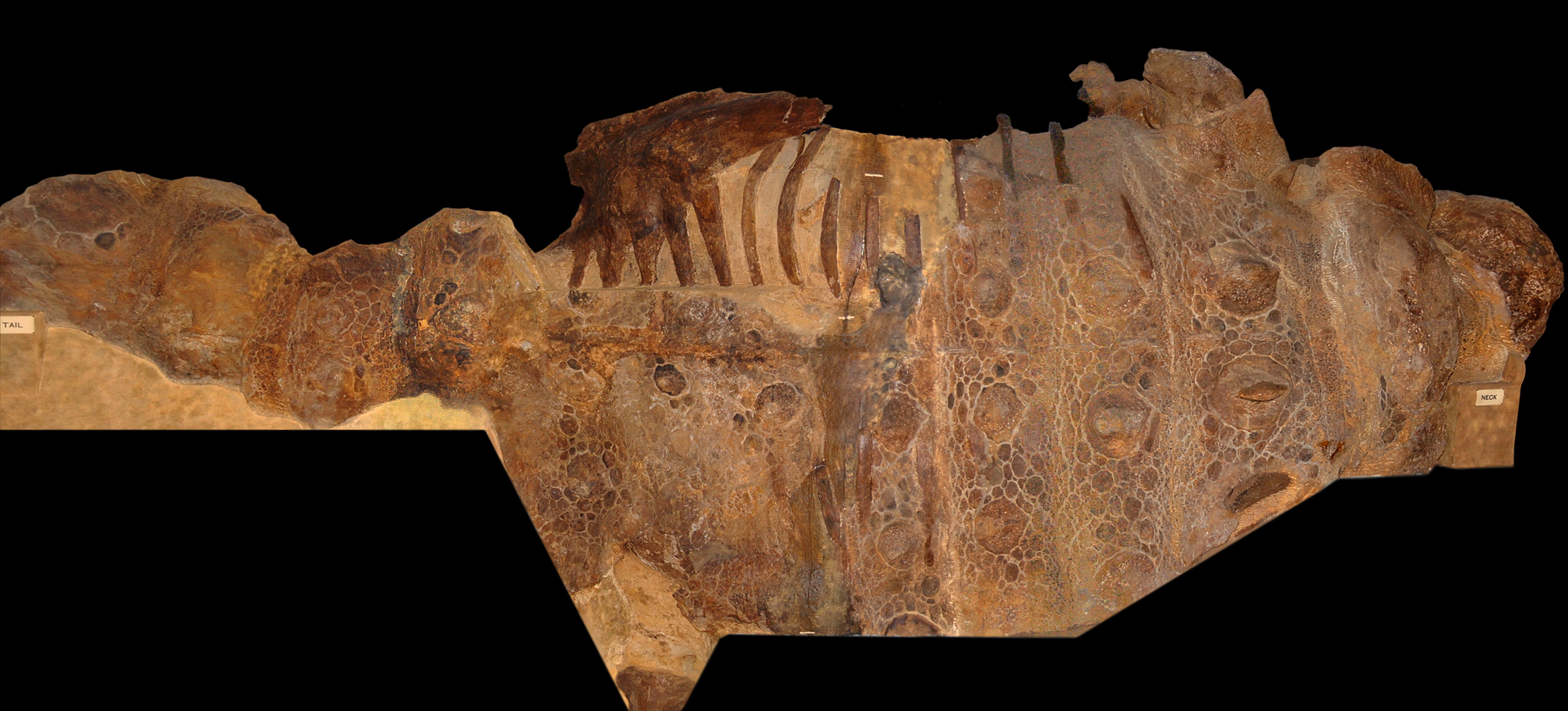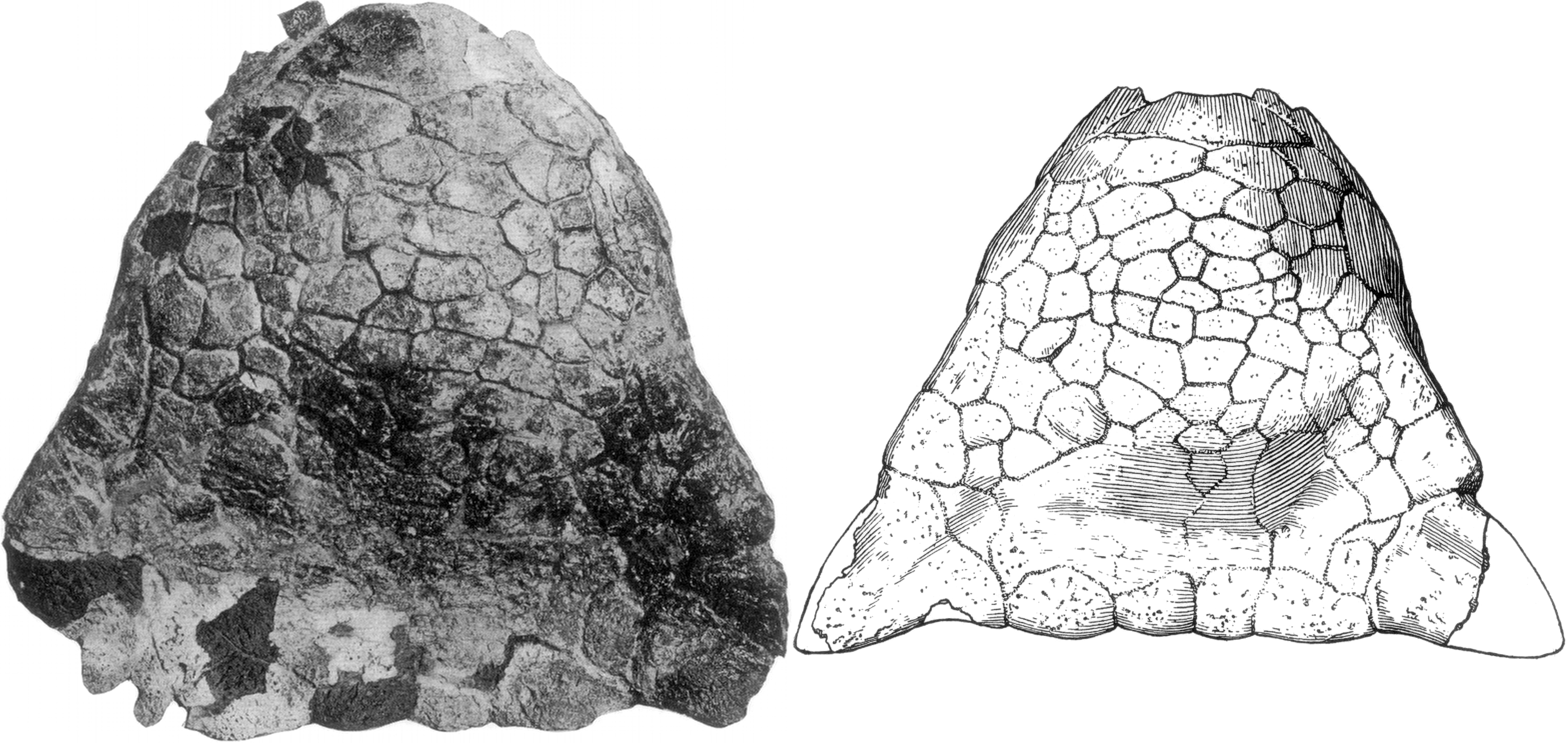|
Syrmosauridae
Ankylosauridae () is a family of armored dinosaurs within Ankylosauria, and is the sister group to Nodosauridae. The oldest known Ankylosaurids date to around 122 million years ago and went extinct 66 million years ago during the Cretaceous–Paleogene extinction event. These animals were mainly herbivorous and were obligate quadrupeds, with leaf-shaped teeth and robust, scute-covered bodies. Ankylosaurids possess a distinctly domed and short snout, wedge-shaped osteoderms on their skull, scutes along their torso, and a tail club. Ankylosauridae is exclusively known from the northern hemisphere, with specimens found in western North America, Europe, and East Asia. The first discoveries within this family were of the genus ''Ankylosaurus'', by Peter Kaiser and Barnum Brown in Montana in 1906. Brown went on to name Ankylosauridae and the subfamily Ankylosaurinae in 1908. Anatomy Ankylosaurids are stout, solidly built, armoured dinosaurs. They possess accessory ossifications on c ... [...More Info...] [...Related Items...] OR: [Wikipedia] [Google] [Baidu] |
Maleevus
''Maleevus'' (named in honour of Evgeny Maleev) is an extinct genus of herbivorous ankylosaurid dinosaur from the late Cretaceous, around 90 million years ago (possibly 98-83 Ma), of Mongolia. Discovery and naming Between 1946 and 1949, Soviet-Mongolian expeditions uncovered fossils at Shiregin Gashun. In 1952, Soviet palaeontologist Evgenii Aleksandrovich Maleev named some ankylosaurian bone fragments as a new species of '' Syrmosaurus'': ''Syrmosaurus disparoserratus''. The specific name refers to the unequal serrations on the teeth.Maleev E.A., 1952, "Новый анқилосавр из вернего мела Монголии", ''Doklady Akademii Nauk, SSSR'' 87: 273-276 The holotype, PIN 554/I, was found in a layer of the Bayan Shireh Formation dating from the Cenomanian-Santonian. It consists of two upper jawbones, left and right maxillae. Maleev erroneously assumed these represented the lower jaws. Referred was specimen PIN 554/2-1, the rear of the skull of another indi ... [...More Info...] [...Related Items...] OR: [Wikipedia] [Google] [Baidu] |
Scolosaurus Thronus
''Scolosaurus'' is an extinct genus of ankylosaurid dinosaurs within the subfamily Ankylosaurinae. It is known from the lower levels of the Dinosaur Park Formation and upper levels of the Oldman Formation in the Late Cretaceous (latest middle Campanian stage, about 76.5 Ma ago) of Alberta, Canada. It contains two species, ''S. cutleri'' and ''S. thronus''. The type species, ''S. cutleri'', measured up to in length and in body mass. Discovery ''Scolosaurus'' was named by Franz Nopcsa von Felső-Szilvás in 1928, based on holotype NHMUK R.5161, a nearly complete specimen that preserves the entire skeleton except for the distal end of the tail, the right forelimb, the right hindlimb, and the skull. The rare preservation of osteoderms and skin impression are also present. The fossil skeleton was discovered by William Edmund Cutler, an independent fossil collector in 1914 at Quarry 80 of the Deadlodge Canyon locality. It was collected from the bottom of the Dinosaur Park Form ... [...More Info...] [...Related Items...] OR: [Wikipedia] [Google] [Baidu] |
Ankylosauria
Ankylosauria is a group of herbivorous dinosaurs of the order Ornithischia. It includes the great majority of dinosaurs with armor in the form of bony osteoderms, similar to turtles. Ankylosaurs were bulky quadrupeds, with short, powerful limbs. They are known to have first appeared in the Middle Jurassic, and persisted until the end of the Cretaceous Period. The two main families of Ankylosaurs, Nodosauridae and Ankylosauridae are primarily known from the Northern Hemisphere, but the more basal Parankylosauria are known from southern Gondwana during the Cretaceous. Ankylosauria was first named by Henry Fairfield Osborn in 1923.Osborn, H. F. (1923). "Two Lower Cretaceous dinosaurs of Mongolia." ''American Museum Novitates'', 95: 1–1/ref> In the Linnaean classification system, the group is usually considered either a suborder or an infraorder. It is contained within the group Thyreophora, which also includes the stegosaurs, armored dinosaurs known for their combination of plate ... [...More Info...] [...Related Items...] OR: [Wikipedia] [Google] [Baidu] |
Sexual Dimorphism
Sexual dimorphism is the condition where the sexes of the same animal and/or plant species exhibit different morphological characteristics, particularly characteristics not directly involved in reproduction. The condition occurs in most animals and some plants. Differences may include secondary sex characteristics, size, weight, colour, markings, or behavioural or cognitive traits. These differences may be subtle or exaggerated and may be subjected to sexual selection and natural selection. The opposite of dimorphism is ''monomorphism'', which is when both biological sexes are phenotypically indistinguishable from each other. Overview Ornamentation and coloration Common and easily identified types of dimorphism consist of ornamentation and coloration, though not always apparent. A difference in coloration of sexes within a given species is called sexual dichromatism, which is commonly seen in many species of birds and reptiles. Sexual selection leads to the exaggerated dim ... [...More Info...] [...Related Items...] OR: [Wikipedia] [Google] [Baidu] |
Skull Of Ankylosaurus
The skull is a bone protective cavity for the brain. The skull is composed of four types of bone i.e., cranial bones, facial bones, ear ossicles and hyoid bone. However two parts are more prominent: the cranium and the mandible. In humans, these two parts are the neurocranium and the viscerocranium (facial skeleton) that includes the mandible as its largest bone. The skull forms the anterior-most portion of the skeleton and is a product of cephalisation—housing the brain, and several sensory structures such as the eyes, ears, nose, and mouth. In humans these sensory structures are part of the facial skeleton. Functions of the skull include protection of the brain, fixing the distance between the eyes to allow stereoscopic vision, and fixing the position of the ears to enable sound localisation of the direction and distance of sounds. In some animals, such as horned ungulates (mammals with hooves), the skull also has a defensive function by providing the mount (on the frontal ... [...More Info...] [...Related Items...] OR: [Wikipedia] [Google] [Baidu] |
Ghostbusters
''Ghostbusters'' is a 1984 American Supernatural fiction, supernatural comedy film directed and produced by Ivan Reitman, and written by Dan Aykroyd and Harold Ramis. It stars Bill Murray, Aykroyd, and Ramis as Peter Venkman, Ray Stantz, and Egon Spengler, three eccentric parapsychologists who start a ghost-catching business in New York City. It also stars Sigourney Weaver and Rick Moranis, and features Annie Potts, William Atherton, and Ernie Hudson in supporting roles. Based on his own fascination with spirituality, Aykroyd conceived ''Ghostbusters'' as a project starring himself and John Belushi, in which they would venture through time and space battling supernatural threats. Following Belushi's death in 1982, and with Aykroyd's concept deemed financially impractical, Ramis was hired to help rewrite the script to set it in New York City and make it more realistic. It was the first comedy film to employ expensive special effects, and Columbia Pictures, concerned about its ... [...More Info...] [...Related Items...] OR: [Wikipedia] [Google] [Baidu] |
Zuul
''Zuul'' is a genus of herbivorous ankylosaurine dinosaur from the Campanian Judith River Formation of Montana. The type species is ''Zuul crurivastator''. It is known from a complete skull and tail, which represents the first ankylosaurin known from a complete skull and tail club, as well as the most complete ankylosaurid specimen thus far recovered from North America. The specimen also preserved ''in situ'' osteoderms, keratin, and skin remains. Discovery and naming In 2014, Theropoda Expeditions LLC was excavating a possible ''Gorgosaurus'' specimen near Havre, Montana. On 16 May, a skid-steer loader removing a -high overburden unexpectedly hit upon an ankylosaurian tail club. An almost complete ankylosaur skeleton proved to be present. As it had not been eroded on the surface, it was in pristine condition. It was found overturned, with the stomach facing upwards. The skeleton was largely articulated, but the skull and some neck vertebrae were separated from the main torso, ... [...More Info...] [...Related Items...] OR: [Wikipedia] [Google] [Baidu] |
Vertebra
The spinal column, a defining synapomorphy shared by nearly all vertebrates,Hagfish are believed to have secondarily lost their spinal column is a moderately flexible series of vertebrae (singular vertebra), each constituting a characteristic irregular bone whose complex structure is composed primarily of bone, and secondarily of hyaline cartilage. They show variation in the proportion contributed by these two tissue types; such variations correlate on one hand with the cerebral/caudal rank (i.e., location within the backbone), and on the other with phylogenetic differences among the vertebrate taxa. The basic configuration of a vertebra varies, but the bone is its ''body'', with the central part of the body constituting the ''centrum''. The upper (closer to) and lower (further from), respectively, the cranium and its central nervous system surfaces of the vertebra body support attachment to the intervertebral discs. The posterior part of a vertebra forms a vertebral arch ... [...More Info...] [...Related Items...] OR: [Wikipedia] [Google] [Baidu] |
Tail Club
In zoology, a club is a bony mass at the end of the tail of some dinosaurs and of some mammals, most notably the ankylosaurids and the glyptodonts, as well as meiolaniid turtles. It is thought that this was a form of defensive armour or weapon that was used to defend against predators, much in the same way as a thagomizer, possessed by stegosaurids, though at least in glyptodonts it is hypothesized it was used in fighting for mating rights. Among dinosaurs, the club was present mainly in ankylosaurids, although sauropods like ''Shunosaurus'' also possessed a tail club. The tail club is most often depicted on ''Ankylosaurus'', especially in encounters with larger predators such as ''Tyrannosaurus''. Victoria Arbour has established that ankylosaurid tails could generate enough force to break bone during impacts. In a separate study, Arbour suggested tail clubs as well as large armoured herbivores as a whole evolve when animals are too large to hide and too small to avoid predation ... [...More Info...] [...Related Items...] OR: [Wikipedia] [Google] [Baidu] |
Ossicles
The ossicles (also called auditory ossicles) are three bones in either middle ear that are among the smallest bones in the human body. They serve to transmit sounds from the air to the fluid-filled labyrinth (cochlea). The absence of the auditory ossicles would constitute a moderate-to-severe hearing loss. The term "ossicle" literally means "tiny bone". Though the term may refer to any small bone throughout the body, it typically refers to the malleus, incus, and stapes (hammer, anvil, and stirrup) of the middle ear. Structure The ossicles are, in order from the eardrum to the inner ear (from superficial to deep): the malleus, incus, and stapes, terms that in Latin are translated as "the hammer, anvil, and stirrup". * The malleus ( la, "hammer") articulates with the incus through the incudomalleolar joint and is attached to the tympanic membrane (eardrum), from which vibrational sound pressure motion is passed. * The incus ( la, "anvil") is connected to both the other bones. * ... [...More Info...] [...Related Items...] OR: [Wikipedia] [Google] [Baidu] |
Ankylosaurus Tail Terminology
''Ankylosaurus'' is a genus of armored dinosaur. Its fossils have been found in geological formations dating to the very end of the Cretaceous Period, about 68–66 million years ago, in western North America, making it among the last of the non-avian dinosaurs. It was named by Barnum Brown in 1908; it is monotypic, containing only ''A. magniventris''. The generic name means "fused" or "bent lizard", and the specific name means "great belly". A handful of specimens have been excavated to date, but a complete skeleton has not been discovered. Though other members of Ankylosauria are represented by more extensive fossil material, ''Ankylosaurus'' is often considered the archetypal member of its group, despite having some unusual features. Possibly the largest-known ankylosaurid, ''Ankylosaurus'' is estimated to have been between long and to have weighed between . It was quadrupedal, with a broad, robust body. It had a wide, low skull, with two horns pointing backward from the b ... [...More Info...] [...Related Items...] OR: [Wikipedia] [Google] [Baidu] |
Ankylosaurus
''Ankylosaurus'' is a genus of armored dinosaur. Its fossils have been found in geological formations dating to the very end of the Cretaceous Period, about 68–66 million years ago, in western North America, making it among the last of the non-avian dinosaurs. It was named by Barnum Brown in 1908; it is monotypic, containing only ''A. magniventris''. The generic name means "fused" or "bent lizard", and the specific name means "great belly". A handful of specimens have been excavated to date, but a complete skeleton has not been discovered. Though other members of Ankylosauria are represented by more extensive fossil material, ''Ankylosaurus'' is often considered the archetypal member of its group, despite having some unusual features. Possibly the largest-known ankylosaurid, ''Ankylosaurus'' is estimated to have been between long and to have weighed between . It was quadrupedal, with a broad, robust body. It had a wide, low skull, with two horns pointing backward from the b ... [...More Info...] [...Related Items...] OR: [Wikipedia] [Google] [Baidu] |








